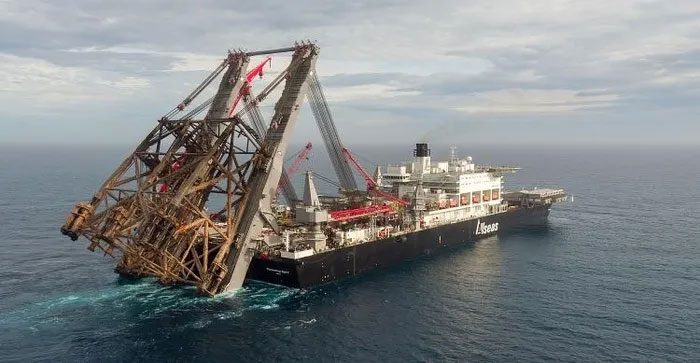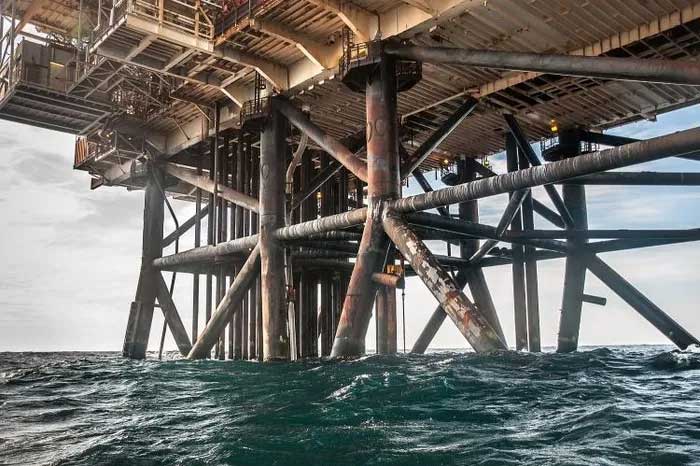The old oil rigs, once a magnificent symbol of the fossil fuel era, are set to be reborn at a “graveyard” construction site in southwestern Norway to serve a new role in the circular economy.
Specifically, three massive and outdated modules, weighing a total of 40,000 tons of material, will be dismantled and reduced to smaller pieces, with 98% of the materials being recycled.

Removing the Gyda oil rig from the sea surface.
Sturla Magnus, a senior manager at Aker Solutions—a company specializing in oil and gas infrastructure—stated: “If you come back here in a year and a half, you will see nothing at all.”
The company is currently processing three major assets: the Gyda oil rig (which ceased operations in 2020) and two inactive rigs from the Valhall oil field.
After conducting safety inspections, electrical equipment and hazardous materials such as asbestos will be removed. The remaining massive hollow machine casings will be sent to cutting machines.
Dozens of thousands of tons of high-quality steel from the machine casings can be reused in new oil rigs, industrial projects, or even offshore wind turbines.
Project dismantling director Thomas Nygård explained: “This steel can withstand the harsh weather conditions of the North Sea. In other words, it’s the best quality steel.”
Today, the community emphasizes the recycling trend of companies by building and installing more oil and gas infrastructure rather than demolishing it.
According to various estimates, one kilogram of recycled steel has 58-70% less greenhouse gas emissions compared to one kilogram of brand new steel.
10,000 Structures Need Dismantling
As the North Sea is one of the oldest hydrocarbon extraction sites in the world, many oil and gas structures are reaching the end of their life cycle.

Dozens of thousands of tons of high-quality steel can be reused in new oil rigs.
According to a 2021 report, the Oil and Gas UK (OGUK) trade association—later renamed Offshore Energies UK (OEUK)—estimated that over 1 million tons of total rig weight would be removed from the seas in this decade.
A few years ago, OGUK reported this number as 200,000 tons. However, the total volume has increased amid market expansion and development.
Mr. Magnus added: “Globally, there may be nearly 10,000 offshore oil and gas structures that will need to ‘swim’ ashore at some point.”
The dismantling and recycling plan at Aker Solutions is expected to last until 2028.
Many Giants Hesitant
One of Norway’s oldest oil rigs, Statfjord A, has been in operation since 1979. The rig was scheduled to cease operations in 2022. However, in 2020, the Norwegian energy giant Equinor decided to extend the rig’s lifespan until 2027.
The two rigs, Statfjord B and C, from the Statfjord hydrocarbon field were also granted an extension of their operational life at least until 2035.
Oil and gas companies indicated that they want to extract the “significant” remaining hydrocarbons in the wells, especially in light of rising oil prices.
Ecological Benefits
Does everything need to disappear? Many environmental activists do not think so. According to the Norwegian branch of the environmental organization Friends of the Earth, the concrete legs of the original oil and gas structures, or the metal bases from later constructions, will create “wonderful” artificial reefs due to the holes and roughness of the rig legs.
Marine biologist Per-Erik Schulze, an advisor to Friends of the Earth, added: “Many large fish species live near oil rigs because the area prohibits fishing. As a result, fish in the area can live up to ten years.”
Therefore, this NGO recommends leaving the concrete pillars intact and establishing marine reserves around them. It is known that the complete removal of all components of oil and gas structures is extremely complex.
After decades of depleting the ocean floor, the oil industry will contribute to protecting marine ecosystems.

















































